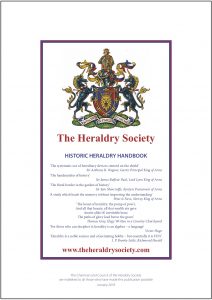The best part of this little booklet from the Heraldry Society in England is that it provides dates for when various types of armorial practices were introduced, along with citations to the reference works they drew those dates from.

(PDF, 20 pages)
An achievement is an integrated display of a person’s armory and honors, including in various combinations, a device, helm, coronet, crest, supporters, motto, order badges, and other elements that differed between individuals and in various times and places.
I don’t have much experience with illustrating armorial achievements, and it’s not something for which we have much established tradition here in the East Kingdom of the SCA, but I’m interested in exploring this area further. Continue reading “Armorial Achievement for Alaxandair Mórda”
Mistress Sofya La Rus recently filmed this video, edited and produced by Lord Ivo Blackhawk, which provides a brief introduction to two useful online resources: the Pictorial Dictionary of Heraldry at mistholme.com, and the SCA Heraldry Wiki at scaheraldry.info.
Some elements are so distinctively suggestive of independent armorial displays that there are rules that limit their use as part of a larger design.
Inescutcheons, cantons, pennons, and sails should not look like they are displaying secondary arms that the submittor has no right to display.
— [Artair MacArtair of Orkney, Return, May 1983 LoAR]
As noted above, this protection applies to single escutcheons, cantons, banners, and sails, but the rules are slightly different for each of these shapes, as I will catalog further below. Continue reading “Rules on the Appearance of Armorial Displays Within Armory”
During my recent review of precedents on “independent forms of armorial display” I collected a number of decisions that document how the Society’s College of Arms developed its current rules.
Some of those older precedents are no longer relevant, but I figured I’d post them here for those who are interested in the history of this subject. Continue reading “Precedent Review: May Flags and Sails Be Divided or Charged?”
During my recent review of precedents on “independent forms of armorial display” I collected a number of decisions that document how the Society’s College of Arms developed its current rules.
Some of those older precedents are no longer relevant, but I figured I’d post them here for those who are interested in the history of this subject. Continue reading “Precedent Review: Can Lozenges, Roundels, and Delfs be Escutcheons of Pretense?”
While putting together my recent summary of which charges can be considered an armorial display, I looked at a lot of old decisions that document how the Society’s College of Arms developed the current rules.
Some of those older precedents are no longer relevant, but I figured I’d post them here for those who are interested in the history of this subject. Continue reading “Precedent Review: Can Plain Lozenges and Roundels Be Used as Fieldless Badges?”
The College of Arms has a rule commonly phrased as “we do not register fieldless badges that appear to be independent forms of armorial display.”
Below, I will attempt to explain this sometimes-confusing rule, catalogue which shapes are considered to be “forms of armorial display,” and note features which cause this rule to not apply. Continue reading “Charges Which Can Appear To Be An Armorial Display in a Fieldless Badge”
The Stemmario Trivulziano is a fifteenth-century Italian armorial featuring the Milan’s ruling family the Visconti and many of their allies and neighbors, believed to be painted by Gian Antonio da Tradate somewhere around around 1465. It takes its name from its owner, Gian Giacomo Trivulzio, an independent mercenary commander, who might have made good use of it in identifying military units on the battlefields of Italy.
Unfortunately, for a long time the only way to view the Stemmario Trivulziano has been to either finagle an invitation to the library where it is held inside Milan’s Sforza Castle, or to purchase a lovely bound edition for € 296 (about $350). As those options were both out of the reach of many amateur armorialists, the rest of us had to make do with a few isolated pages which had been scanned and posted online. Continue reading “Downloading the Stemmario Trivulziano”
A couple of months ago I posted about extracting Vigil Raber’s sixteenth-century Wappenbuch der Arlberg-Bruderschaft from the “click to pan and zoom” web interface in which it is hosted, but as it turns out, this is not the only armorial manuscript created by this brotherhood.
For a bit of context, the Brotherhood of St. Christopher was established in the fourteenth century to shelter and assist travelers who were crossing the Alps using the Arlberg pass between Italy and Austria. For hundreds of years, they recorded the identities of armigerous travelers (and donors to the brotherhood) by painting the arms in a series of manuscript guest books.
In addition to Vigil Raber’s manuscript (circa 1548), several other copies of these books have survived to the present, although it appears that others were lost over the centuries. Continue reading “Downloading the Arlberg “Viennese Manuscript””